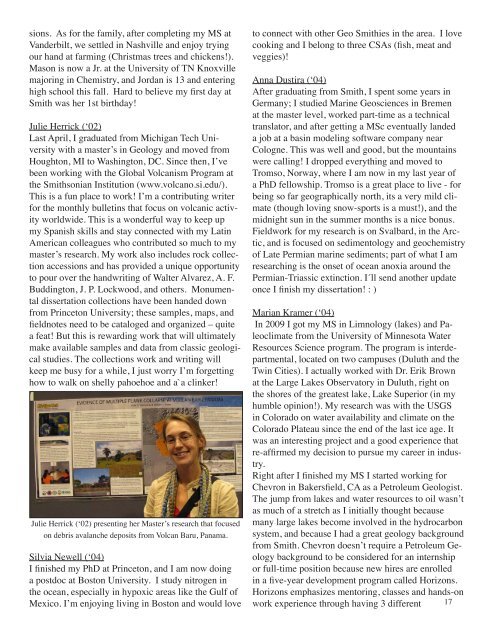Department of Geosciences - Clark Science Center - Smith College
Department of Geosciences - Clark Science Center - Smith College
Department of Geosciences - Clark Science Center - Smith College
Create successful ePaper yourself
Turn your PDF publications into a flip-book with our unique Google optimized e-Paper software.
sions. As for the family, after completing my MS at<br />
Vanderbilt, we settled in Nashville and enjoy trying<br />
our hand at farming (Christmas trees and chickens!).<br />
Mason is now a Jr. at the University <strong>of</strong> TN Knoxville<br />
majoring in Chemistry, and Jordan is 13 and entering<br />
high school this fall. Hard to believe my first day at<br />
<strong>Smith</strong> was her 1st birthday!<br />
Julie Herrick (‘02)<br />
Last April, I graduated from Michigan Tech University<br />
with a master’s in Geology and moved from<br />
Houghton, MI to Washington, DC. Since then, I’ve<br />
been working with the Global Volcanism Program at<br />
the <strong>Smith</strong>sonian Institution (www.volcano.si.edu/).<br />
This is a fun place to work! I’m a contributing writer<br />
for the monthly bulletins that focus on volcanic activity<br />
worldwide. This is a wonderful way to keep up<br />
my Spanish skills and stay connected with my Latin<br />
American colleagues who contributed so much to my<br />
master’s research. My work also includes rock collection<br />
accessions and has provided a unique opportunity<br />
to pour over the handwriting <strong>of</strong> Walter Alvarez, A. F.<br />
Buddington, J. P. Lockwood, and others. Monumental<br />
dissertation collections have been handed down<br />
from Princeton University; these samples, maps, and<br />
fieldnotes need to be cataloged and organized – quite<br />
a feat! But this is rewarding work that will ultimately<br />
make available samples and data from classic geological<br />
studies. The collections work and writing will<br />
keep me busy for a while, I just worry I’m forgetting<br />
how to walk on shelly pahoehoe and a`a clinker!<br />
Julie Herrick (‘02) presenting her Master’s research that focused<br />
on debris avalanche deposits from Volcan Baru, Panama.<br />
Silvia Newell (‘04)<br />
I finished my PhD at Princeton, and I am now doing<br />
a postdoc at Boston University. I study nitrogen in<br />
the ocean, especially in hypoxic areas like the Gulf <strong>of</strong><br />
Mexico. I’m enjoying living in Boston and would love<br />
to connect with other Geo <strong>Smith</strong>ies in the area. I love<br />
cooking and I belong to three CSAs (fish, meat and<br />
veggies)!<br />
Anna Dustira (‘04)<br />
After graduating from <strong>Smith</strong>, I spent some years in<br />
Germany; I studied Marine <strong>Geosciences</strong> in Bremen<br />
at the master level, worked part-time as a technical<br />
translator, and after getting a MSc eventually landed<br />
a job at a basin modeling s<strong>of</strong>tware company near<br />
Cologne. This was well and good, but the mountains<br />
were calling! I dropped everything and moved to<br />
Tromso, Norway, where I am now in my last year <strong>of</strong><br />
a PhD fellowship. Tromso is a great place to live - for<br />
being so far geographically north, its a very mild climate<br />
(though loving snow-sports is a must!), and the<br />
midnight sun in the summer months is a nice bonus.<br />
Fieldwork for my research is on Svalbard, in the Arctic,<br />
and is focused on sedimentology and geochemistry<br />
<strong>of</strong> Late Permian marine sediments; part <strong>of</strong> what I am<br />
researching is the onset <strong>of</strong> ocean anoxia around the<br />
Permian-Triassic extinction. I´ll send another update<br />
once I finish my dissertation! : )<br />
Marian Kramer (‘04)<br />
In 2009 I got my MS in Limnology (lakes) and Paleoclimate<br />
from the University <strong>of</strong> Minnesota Water<br />
Resources <strong>Science</strong> program. The program is interdepartmental,<br />
located on two campuses (Duluth and the<br />
Twin Cities). I actually worked with Dr. Erik Brown<br />
at the Large Lakes Observatory in Duluth, right on<br />
the shores <strong>of</strong> the greatest lake, Lake Superior (in my<br />
humble opinion!). My research was with the USGS<br />
in Colorado on water availability and climate on the<br />
Colorado Plateau since the end <strong>of</strong> the last ice age. It<br />
was an interesting project and a good experience that<br />
re-affirmed my decision to pursue my career in industry.<br />
Right after I finished my MS I started working for<br />
Chevron in Bakersfield, CA as a Petroleum Geologist.<br />
The jump from lakes and water resources to oil wasn’t<br />
as much <strong>of</strong> a stretch as I initially thought because<br />
many large lakes become involved in the hydrocarbon<br />
system, and because I had a great geology background<br />
from <strong>Smith</strong>. Chevron doesn’t require a Petroleum Geology<br />
background to be considered for an internship<br />
or full-time position because new hires are enrolled<br />
in a five-year development program called Horizons.<br />
Horizons emphasizes mentoring, classes and hands-on<br />
work experience through having 3 different 17
















